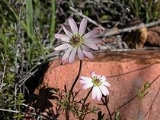
Anemone tuberosa
Encyclopedia
Anemone tuberosa is a herbaceous
plant species in the genus Anemone
and family Ranunculaceae
. Plants grow 10 to 30, sometimes 40 cm tall, from a woody-like tuber shaped like a caudex. Plants with 1 to 3 basal leaves that are 1 or 2 times ternate. The basal leaves few with long petioles and deeply 3-parted with leaflets lacking stems or rarely with a stalk. Plants flowering early to late spring with the flowers composed of 8 to 10 sepals normally white or pink colored, 10 to 14 mm long. The plants produce one peduncle
with one solitary flower or 2-5 flowered cymes. Fruits in heads fusiform in shape, with 7-20 cm long pedicels. Fruits called achenes measure 2.5-3.5 mm long and 2-2.5 mm wide with a rounded outline and flat in shape, densely woolly, not winged also with straight 1.5 mm long beaks.
Anemone tuberosa is native to south central western North America mostly in Nevada and New Mexico and Northern Mexico but also west to California and East to Texas. This spring flowering plant is found on rocky slopes and along stream banks. Anemone tuberosa is part of a species complex that includes 6 to 9 species native from south western and central USA to South America For the most part all produce tubers or caudex-like tubers.
Herbaceous
A herbaceous plant is a plant that has leaves and stems that die down at the end of the growing season to the soil level. They have no persistent woody stem above ground...
plant species in the genus Anemone
Anemone
Anemone , is a genus of about 120 species of flowering plants in the buttercup family Ranunculaceae in the north and south temperate zones...
and family Ranunculaceae
Ranunculaceae
Ranunculaceae are a family of about 1700 species of flowering plants in about 60 genera, distributed worldwide....
. Plants grow 10 to 30, sometimes 40 cm tall, from a woody-like tuber shaped like a caudex. Plants with 1 to 3 basal leaves that are 1 or 2 times ternate. The basal leaves few with long petioles and deeply 3-parted with leaflets lacking stems or rarely with a stalk. Plants flowering early to late spring with the flowers composed of 8 to 10 sepals normally white or pink colored, 10 to 14 mm long. The plants produce one peduncle
Peduncle (botany)
In botany, a peduncle is a stem supporting an inflorescence, or after fecundation, an infructescence.The peduncle is a stem, usually green and without leaves, though sometimes colored or supporting small leaves...
with one solitary flower or 2-5 flowered cymes. Fruits in heads fusiform in shape, with 7-20 cm long pedicels. Fruits called achenes measure 2.5-3.5 mm long and 2-2.5 mm wide with a rounded outline and flat in shape, densely woolly, not winged also with straight 1.5 mm long beaks.
Anemone tuberosa is native to south central western North America mostly in Nevada and New Mexico and Northern Mexico but also west to California and East to Texas. This spring flowering plant is found on rocky slopes and along stream banks. Anemone tuberosa is part of a species complex that includes 6 to 9 species native from south western and central USA to South America For the most part all produce tubers or caudex-like tubers.

